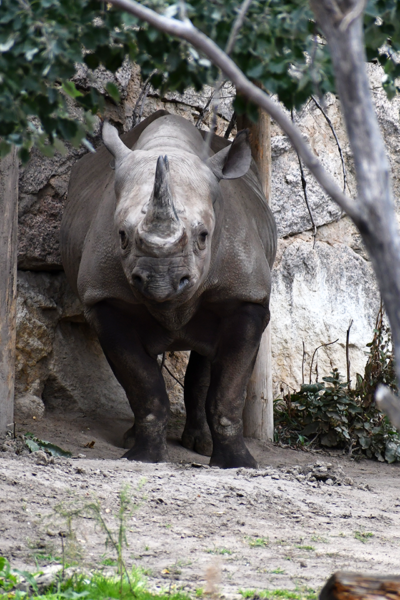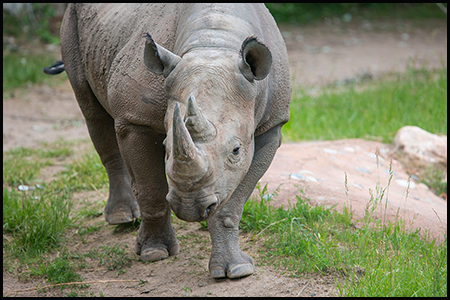
Looking at Jumbe [JOOM-bay], Cheyenne Mountain Zoo’s 2,800-pound Eastern black rhinoceros, visitors might assume that his demeanor matches his stature. On the contrary, according to Annie Dinwiddie, senior keeper in Encounter Africa who has worked with Jumbe for nine years.
“He’s actually really gentle,” said Dinwiddie. “I have worked with three black rhinos and two greater one-horned rhinos, and they’re all amazing, but there’s something special about Jumbe. He has this look where he tucks his upper lip in, and he makes eye contact with you, and you kind of just see each other quietly. You can tell he’s really observant.”
20-year-old Jumbe, who came to CMZoo in 2012, is an Eastern black rhino – a species of rhino native to Africa whose most distinguishable feature is its prehensile top lip. Eastern black rhinos’ ‘pointy’ lips help them strip leaves and bark from shrubs and trees in their native landscapes, whereas white rhinos’ flat lips help them most efficiently mow grass in their native African savannahs.
CMZoo guests who participate in Jumbe’s seasonal rhino feeding opportunities know his pointy lips well. At noon every day from March through October (weather permitting), guests can line up in Encounter Africa for a paid opportunity to hand-feed Jumbe. By extending his top lip to wrap it around the produce being offered, he gently accepts it – and usually leaves guests with a slobbery goodbye.
“To be that close to a rhino is a life-changing experience for most of our guests,” said Dinwiddie. “The slobber is part of the fun!”
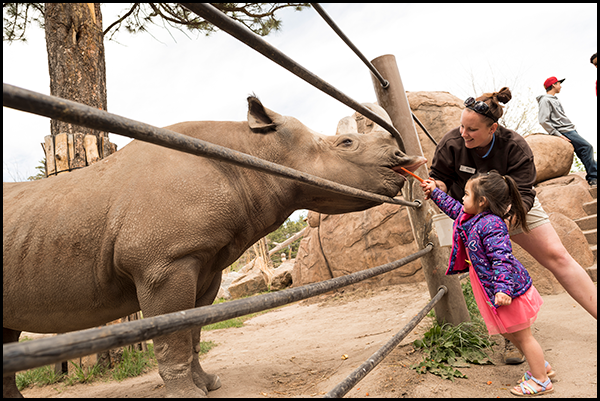
Jumbe’s snack times also help guests make a direct connection with rhino conservation. The $10 cost to participate supports CMZoo’s black rhino and African elephant conservation partner, Tsavo Trust.
Being messy is a way of life for Jumbe, who loves a good mud wallow, which his keepers provide whether he’s inside or outside. He lies down on his side in the mud and rolls around until he has a thick coat of cool, protective mud all over. When he’s inside, he has the option of a hands-on mud bath, courtesy of his keepers.
“Jumbe loves to get a bath, and we happily oblige,” said Dinwiddie. “He walks into a stall where we have access to him from every angle through bollards. We reach in and scrub him with long brushes, warm water and vet-approved soap. After that, we get big handfuls of mud, and he walks over so we can rub it all over him. Sometimes he makes quiet happy little squeaks and really leans into the bollards so we can reach all of his favorite spots.”
Dinwiddie says he likes to get scrubbed between his toes and will even lift his feet up one at a time to tell them where to scrub. If a mud bath isn’t on the day’s agenda, you can bet daily scratches are. Jumbe also likes to be scratched behind his ears and in his armpits, which feel velvety soft compared to the rest of his body, which feels a bit like a cantaloupe.
“Jumbe consistently chooses to spend time with people when it’s an option, and we always have plenty of activities for him to choose to do,” said Dinwiddie. “He’ll be enthusiastically tossing a huge barrel around, or stacking huge tires on his horns, or mud wallowing, but if he sees us, he almost always comes over to see what we’re doing.”
That doesn’t mean he’s longing for attention, though. Jumbe, like the preference of wild male black rhinos, is solitary at the Zoo. Because his genetics are well represented in the assurance population of black rhinos, it’s highly unlikely he’ll be recommended to breed. Apart from his keepers, he seems to enjoy socializing with his elephant neighbors.
“We have seen him and Jambo, one of our six African elephants, standing on either side of bollards next to each other,” said Dinwiddie. “Jambo will smell Jumbe with her trunk, and Jumbe will nudge her with his horn, and they just seem to be enjoying the tactile interaction for a few minutes. But, we don’t think he would enjoy sharing the space with the elephants. He still enjoys having his own space and being able to interact when he chooses to.”
Eastern black rhinos are one of five remaining species of rhinoceros, along with two species native to Indonesia, the Javan and Sumatran rhinos, which each have only 70 or fewer wild individuals remaining. The greater one-horned rhino is native to India and Nepal, with around 4,000 wild individuals remaining. White rhinos are native to Africa and have around 15,000 in the wild. Eastern black rhinos, like Jumbe, are native to Africa with around 6,000 individuals in the wild.
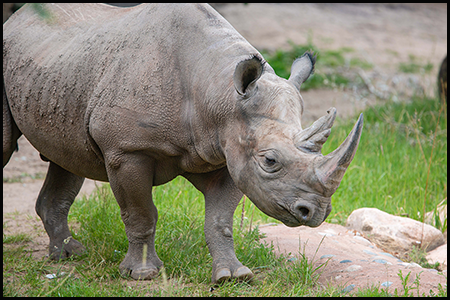
“For most people in the U.S., he’s the only rhino they’ll ever see,” said Dinwiddie. “Even people who visit Africa multiple times aren’t guaranteed to see them, so we’re very aware of what a special opportunity it is to work with or meet Jumbe.”
Tsavo Trust works to protect the last of the big tuskers, which are African elephants with tusks weighing more than 100 pounds, and Eastern black rhinos, in Tsavo National Park, in Kenya. Funds raised through Jumbe’s snack times and scheduled daily seasonal elephant feedings help pay for pilot hours of frontline aerial surveillance that protects rhinos and elephants from poachers seeking their ivory and horns.
Along with funding from the Kratt Family Foundation, CMZoo guests’ support has helped build permanent housing that allows staff to live on the land where these endangered giants live. It has funded the construction of a vehicle maintenance building and special projects in local communities.
“By feeding Jumbe, you’re making a connection with him, and you’re directly supporting his wild counterparts,” said Dinwiddie. “That’s why we’re here, and Jumbe can inspire guests to care for wild rhinos better than any of the rest of us can.”
One way to prevent further destruction of Indonesian habitats where rhinos live is by supporting companies that use sustainable palm oil, rather than using unsustainable palm oil production. Download the free WAZA PalmOil Scan app, launched by CMZoo, Auckland Zoo and Chester Zoo, under the direction of the World Association of Zoos and Aquariums (WAZA) last summer, and scan products before purchasing them. (Learn more and download the app at cmzoo.org/palmoil.)
Jumbe’s attentive gentle nature makes him an excellent voluntary training participant. He participates in target training, positioning his body in different ways so keepers can get closer looks at different parts of him, x-rays, presenting his horn, injection training and blood draws.
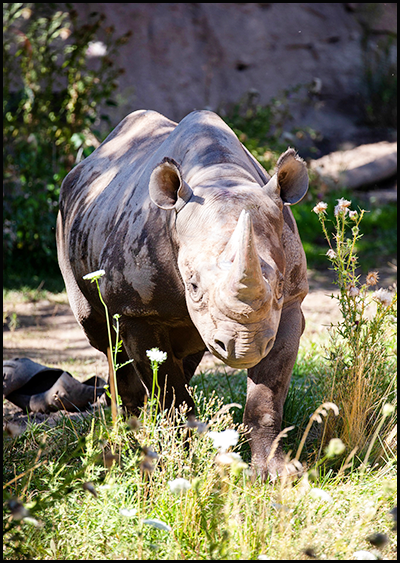
“One of the first things I trained with him on was a blood draw,” said Dinwiddie. “He quickly picked up what we were asking him to do. He presents one of his front legs so we can draw blood from a vein where his skin isn’t as thick. He has been such an exemplary student that we’ve been able to share our training methods with other people who care for rhinos. We communicate with him, and he communicates with us throughout the sessions.”
During blood draw training, Jumbe puts his foot on a black mark on the ground. When he is ready to move on to something else, he knows he can move his foot off that mark, and his trainers will end the training session. His favorite training rewards, or reinforcers as they’re known in the zoo profession, are apple, banana and carrots dipped in peanut butter and jelly, or blueberry bagels – all in vet-approved treat-sized amounts.
“He’s truly amazing, and I just can’t imagine a world without rhinos,” said Dinwiddie. “Rhino and elephant conservation can be complicated. It can be de-motivating because the problem can feel so big that it’s overwhelming, but all of us can make a difference. People can directly support Tsavo Trust by visiting our Zoo, and we can teach them not to purchase rhino products. The leading cause of decline for all five rhino species is horn poaching and habitat loss. We have to stop the demand for rhino horns by educating people that rhino horns don’t contain medicinal materials. Their horns are made of keratin, and are literally no different than a fingernail.”
Next time you’re at CMZoo, stop by Encounter Africa to wave hello to Jumbe and plan your day to line up for a scheduled seasonal feeding opportunity. Even if you don’t make it to feed Jumbe, you’re supporting black rhino conservation by visiting CMZoo. 75¢ from every admission supports local and worldwide conservation efforts through our Quarters for Conservation program.
